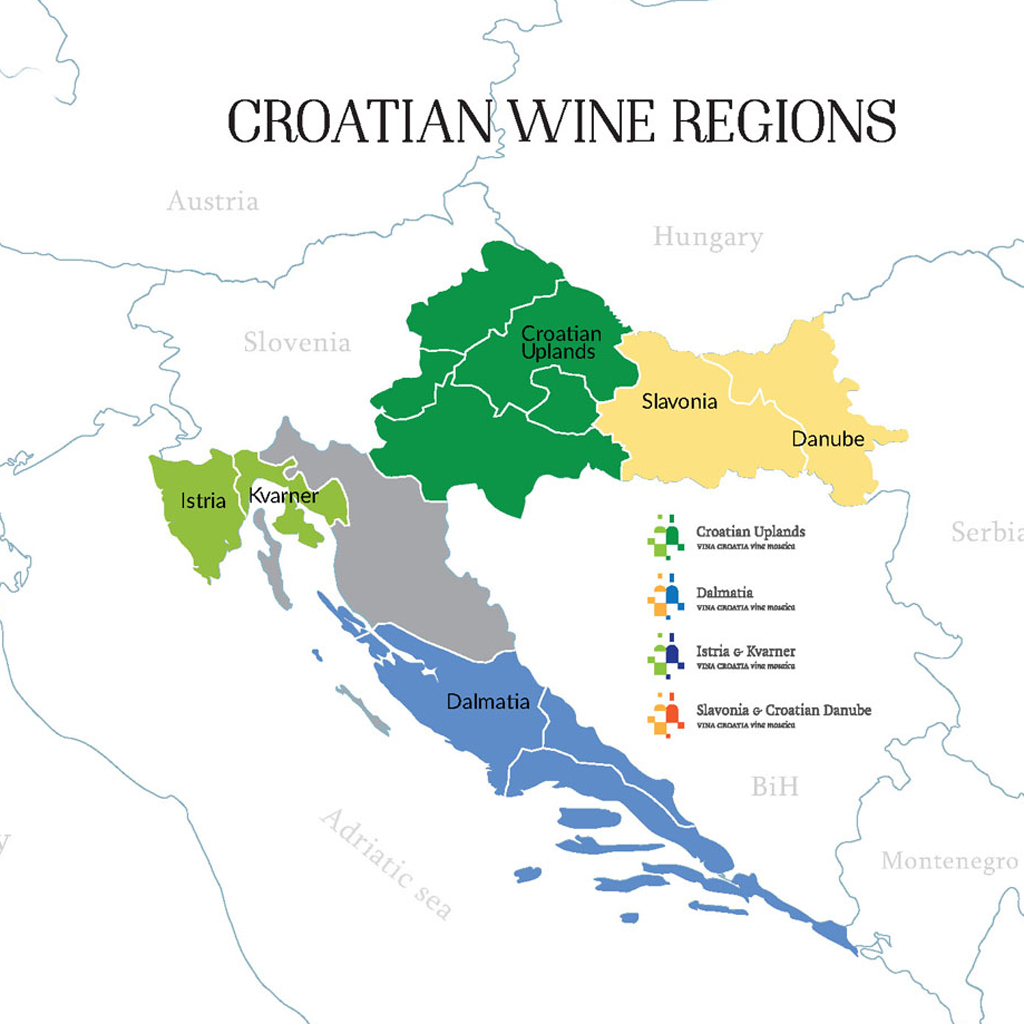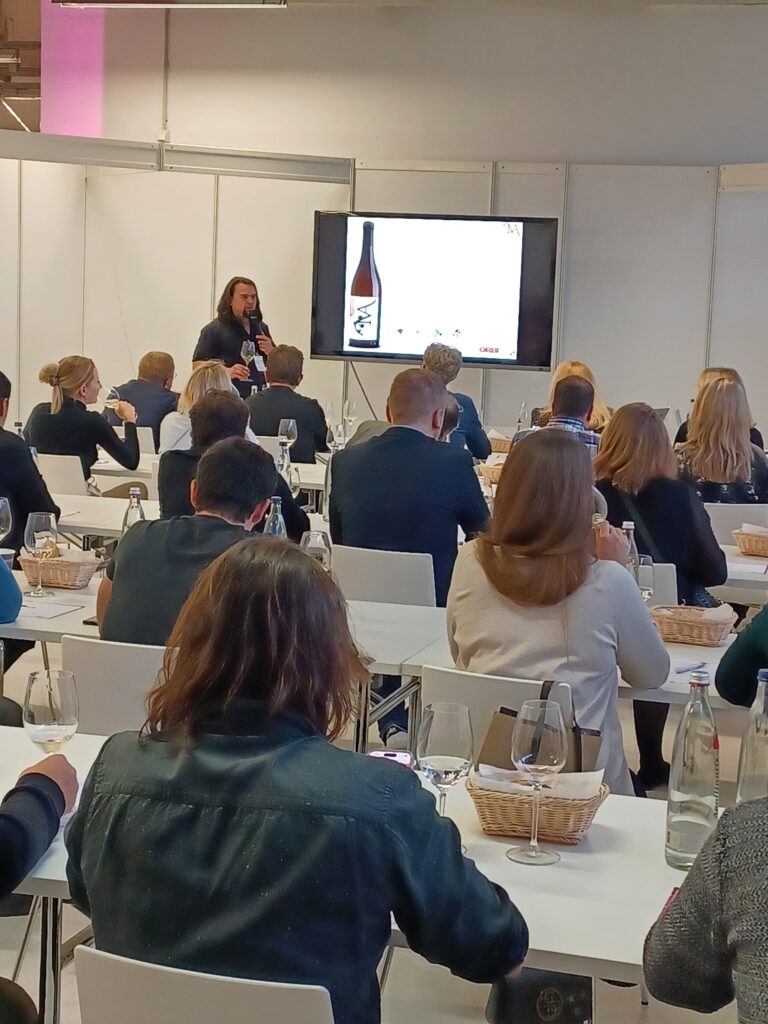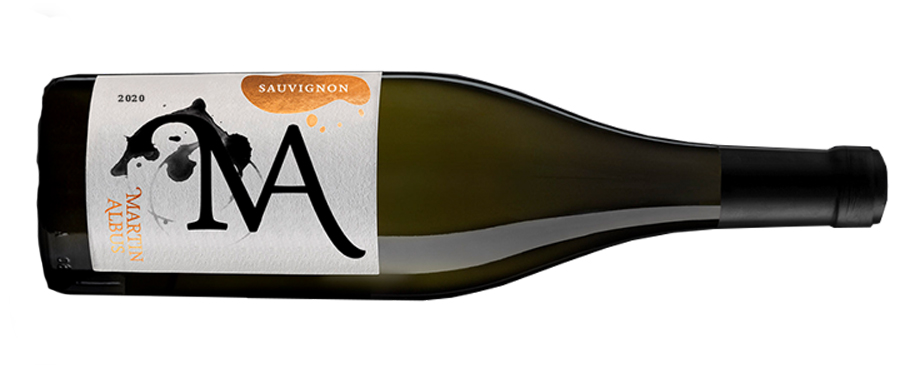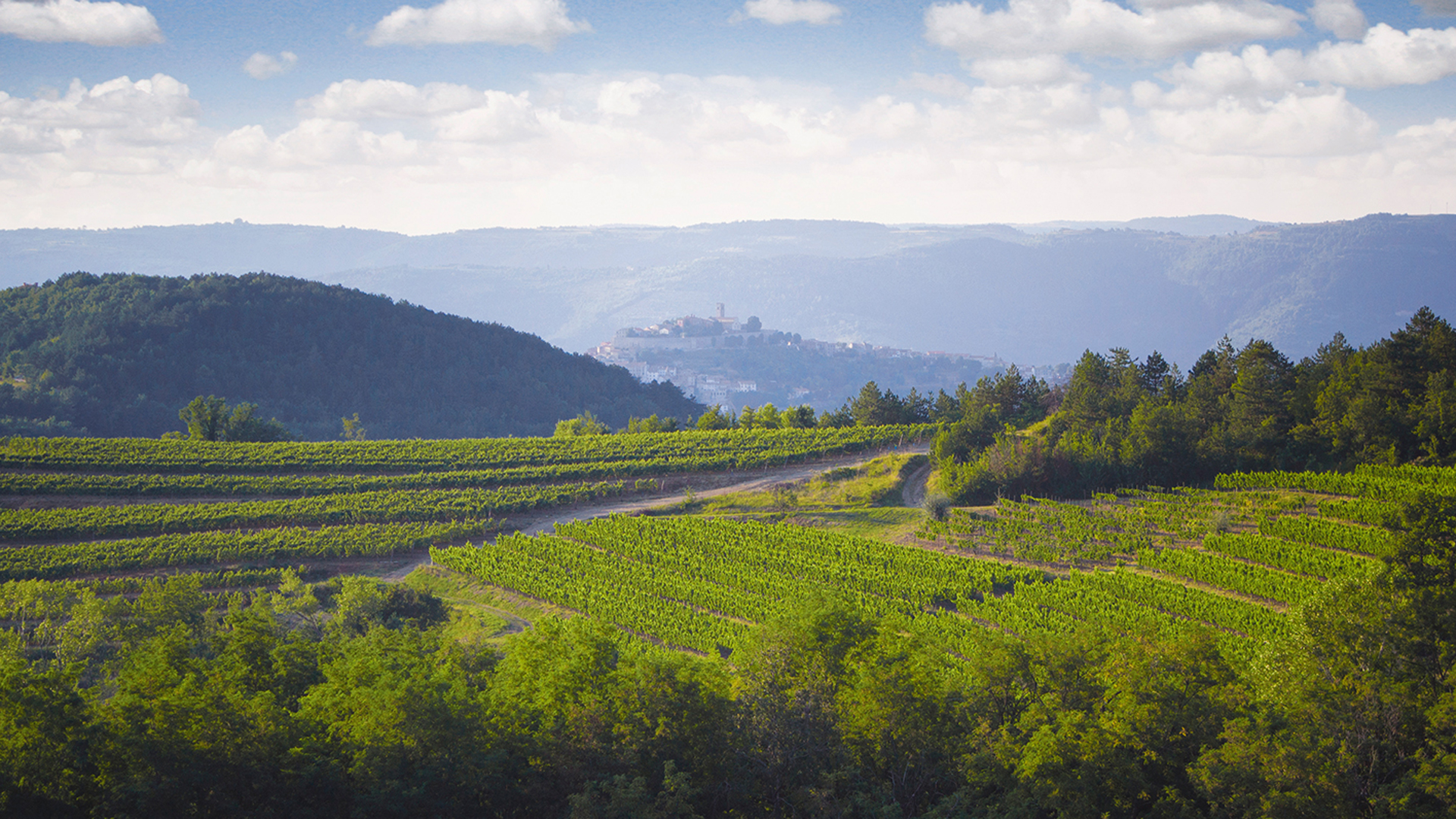In November of this year, Orbico Adriatic Wines invited me to hold a masterclass on Wines of Croatia and Slovenia at the Forum Vini in Munich. I agreed to do so. This is part 2 of the series, in which we dive deep into the terroir of Croatia’s wine regions. Croatia produces about 90 million liters of wine, which is less than 1% of the total volume in the EU (about 150 million hectoliters). Despite being a small producer, Croatia’s wines are rarely exported. However, when found on the export market, they are consistently impressive in quality and price.
We held the masterclass with six wines in front of 30 people in the so-called “Klassenzimmer.” The audience was very engaged with the wines, overflowing the room. The engaging audience, frequently asking questions and showing great interest, highlighted the spark of wine lovers and professionals alike.

Croatian Wine Regions
Croatia is a country with a rich and diverse winemaking history, dating back over 2,500 years. The country’s unique geographical location, Mediterranean climate, and diverse soils have given rise to a wide range of grape varieties and wine styles.
Croatia is divided into three main wine regions: the Coastal Region, the Continental Region, and Central Croatia. Each region has its own unique climate, terroir, and grape varieties.
Coastal Region
The Coastal Region is located along the Adriatic Sea and includes the regions of Istria, Kvarner, and Dalmatia. The region is known for its warm summers and mild winters, which provide ideal conditions for growing red wine grapes. Plavac mali, Croatia’s signature red grape variety, is the most widely planted grape in the Coastal Region. Other notable red varieties include Babić, Crljenak Kaštelanski, and Teran. White wine grapes such as Malvasia Istriana, Pošip, and Žlahtina are also widely planted in the Coastal Region.
Continental Region
The Continental Region is located inland and includes the regions of Slavonia and the Croatian Uplands. The region is known for its cooler summers and colder winters, which provide ideal conditions for growing white wine grapes. Graševina (Riesling), Croatia’s most widely planted grape variety, is the most popular white grape in the Continental Region. In comparison to German Riesling, the Croatians offer a more full-bodied character with a light bitterness. Other notable white varieties include Chardonnay, Pinot Gris, and Sauvignon Blanc. Red wine grapes such as Frankovka (Blaufränkisch), Cabernet Sauvignon, and Merlot are also planted in the Continental Region.
Central Croatia
Central Croatia is located between the Coastal Region and the Continental Region. The region is known for its hilly landscape and diverse soils, which provide ideal conditions for growing a variety of grape varieties. Both red and white wine grapes are widely planted in Central Croatia. Popular red varieties include Pinot Noir, Frankovka, and Cabernet Sauvignon. Popular white varieties include Graševina, Sauvignon Blanc, and Pinot Gris.
Croatian Grape Varieties
Croatia has a wide variety of grape varieties, including both indigenous and international varieties. Some of the most notable indigenous grape varieties include:
Plavac mali: Croatia’s signature red grape variety, known for its full-bodied, fruit-forward wines. Also known as Primitivo or Zinfandel.
Babić: A red grape variety native to the Dalmatia region, known for its bold, tannic wines.
Crljenak Kaštelanski: A red grape variety native to the Kaštela region, known for its rich, complex wines.
Teran: A red grape variety native to the Istria region, known for its acidic, fruit-driven wines.
Malvasia Istriana: A white grape variety native to the Istria region, known for its full-bodied, aromatic wines.
Pošip: A white grape variety native to the Dalmatia region, known for its full-bodied, mineral-driven wines. Its more of a mix between Greco di Tufo (earthy) and Fiano di Avellino (full-bodied, piercing high acidity).
Žlahtina: A white grape variety native to the Kvarner region, known for its crisp, refreshing wines.
The Tasting

Martin Albus Sauvignon Blanc 2022

Established in the northeast, close to Hungary’s border, the historic Martin Albus Winery, founded in 1894, is renowned for its youthful and vibrant single-vineyard wines. Named after winemaker Martin and the Albus family, it boasts a selection of internationally recognized varieties, including a Sauvignon Blanc that clinched a Silver at the Mundus Vini competition.
The wine undergoes a 6-hour cold maceration, followed by a low-temperature fermentation with commercial yeasts. After fermentation, the wine matures for six months on fine lees, adding complexity and texture with a leesy mouthfeel before being filtered for clarity and stability.
Tasting this wine is like an aromatic journey through a tropical orchard, with passion fruit and floral scents leading to a harmonious palate that mirrors these aromas. In the vineyards of ZOI Slavonija, a commitment to quality is clear, with yields as low as 1 kg of grapes per vine producing concentrated flavors. The grapes, hand-harvested on August 30, 2022, from the selective plots of Orahovica Vineyard, encapsulate the essence of the region in each bottle of this exceptional vintage.
Terra Madre Pošip Premium 2022

Located in the wine-rich landscapes of Srednja i Južna Dalmacija, the Terra Madre Winery, established in 2008, has quickly made a name for itself with its authentically Dalmatian wines. Their Pošip, crafted from 100% Pošip grapes, showcases the very soul of Croatian viticulture, being the first white wine in the country to have its own protected designation of origin since 1967.
The winemaking process honors tradition with a 3-hour cold maceration and fermentation using ambient yeasts at low temperatures. The wine matures for four months on fine lees in Inox tanks before filtration, developing its distinct personality.
Terra Madre’s bursts with freshness and minerality, weaving intense tropical notes of pineapple and banana with the distinctive flavors of Mediterranean herbs. Its full body and oily texture are similar to the Greco variety, while a lively acidity and juicy character bring balance to its bold profile.
Pošip grapes are intriguingly shaped like a “scissor,” echoing the tool used for pruning vines, which inspired its name. With a commitment to organic practices since 2013, Terra Madre oversees 100,000 Plavac Mali and 25,000 Pošip vines, with their first harvest in 2010.
Roxanich Montona 2018

Perched amidst the rolling hills of Hrvatska Istra, the Roxanich Winery tells a story of tradition and terroir through its Venezia. The wine presents a lightly cloudy straw yellow color and boasts a pristine character of dried fruits, beeswax, and watermelon. On the palate, it is bone-dry with a moderate body and a light, chalky tannic sensation. There is a high concentration and intensity of the aforementioned fruits, which balance beautifully with the juicy acidity and the wine’s chalky tannin structure.
The winemaking process, shaped by founder Mladen Rožanić’s experiences in the Rhône, starts with a 3-hour cold maceration, followed by fermentation at cool temperatures and malolactic fermentation to mellow the acidity. Impressively, the wine matures for 32 months on fine lees, a step that ensures the wine remains unfiltered, capturing its genuine character.
Roxanich Venezia 2019

The Roxanich Venezia 2019 is a unique cuvée from the Hrvatska Istra region, artfully blending local and international grape varieties—Merlot, Teran, Refosco, and Cabernet Sauvignon. Reflecting the winemaking heritage of the area, each varietal contributes its distinctive qualities, having undergone a lengthy 20-day maceration process. The varietals are vinified either separately or as together being combined to form a cohesive and harmonious red wine. True to artisanal methods, the final product is left unfiltrated, retaining the full spectrum of its natural flavors.
On the palate, the wine is notably lean, with delicate tannins providing structure to the aromas of dark berry flavors that unfold like a vibrant fruit-forward display. With a reductive nature, the Venezia requires some patience, revealing its full complexity after some time to breathe in the glass. Herbal notes, particularly bay leaf, are prominent, alongside an herbaceous quality that pays tribute to La Serenissima—the historical Republic of Venice and the familial roots that inspire this wine.
Terra Madre Plavac mali Barrique 2018

The Terra Madres Plavac mali from Srednja i Južna Dalmacija, reflects a precise dedication to organic viticulture and artful winemaking. The wine, rooted in careful vineyard selection, ferments with native yeasts in stainless steel tanks. It is then aged for 12 months in barrique and a further 12 in the bottle, marrying fruit intensity with oak’s sophistication.
In the glass, the Plavac mali showcases a vibrant ruby red, emitting rich aromas of ripe cherries and plums. On the palate, it balances fruit-forward vibrancy with subtle spices and silk-like tannins, embodying a medium body and refined structure.
Champion Winery’s “Patriot” 2018

The Patriot is a voluptuous blend of Cabernet Franc, Blaufränkisch, Merlot, and Cabernet Sauvignon from ZOI Slavonija. Each varietal is vinified from grapes harvested from selected parcels, followed by a 14-day maceration process. The wines are then artfully assembled into a harmonious red and aged for 24 months in Slavonian oak barrels.
The Patriot presents a deep red-purple color, revealing a full-bodied and powerful wine. It is vivid and fresh, adorned with floral and spicy notes. Dominant ripe flavors of plums, cherries, and blackberries are complemented by layers of berry nuances, dark chocolate, and coffee. Well balanced moderate chalky tannins and moderate lively acidity.
Embracing the Benedictine and Cistercian ethos of “Ora et Labora” (pray and work), the winery is reputedly the world’s only one dedicated to the spirit of combat sports, with the Patriot and Grandmaster as its leading wines. This blend, in particular, has garnered favoritism from our audience, illustrating its widespread appeal.
More info about Croatia: Vina Croatia – vinacroatia.hr
Thanks for Reading!
Glad you dropped by! If the insights here struck a chord, why not share them? And if you’re eager to talk more, I’m all ears – just reach out. Looking for someone to spark inspiration in your masterclass or brand event? Let’s talk and set up something amazing.
Disclaimer
This text was neither commissioned nor compensated. It reflects exclusively my own opinion.

ConVINOsation Podcast Brings EUROVINO Wine Fair to Life
In collaboration with Messe Karlsruhe, we are proud to launch ConVINOsation, a new podcast dedicated to tackling the wine industry’s most pressing topics. Hosted by

Live on Wein Verkauft!
I recently had the opportunity to join freelance consultant Diego Weber from Germany on his podcast, On German!. Over the course of the two-hour episode,

Live on the Morning Show
In July 2024, I had the exciting opportunity to appear on New York’s WTBQ Frank Truatt’s Morning Show, the #1 drive time morning show, with
Challenging Year for French Wines & Spirits Exports 2023
In the year 2023, the French wine and spirits sector navigated through challenging waters to post exports worth €16.2 billion. Despite representing a 5.9% decline from the previous year, this figure stands as the second-highest in the industry’s export history. The volume of exports also saw a considerable reduction, falling by 10.4%. However, the sector managed to maintain its status as the leading contributor to France’s agri-food surplus and the third largest in the nation’s overall trade balance, with a trade surplus of €14.8 billion, down by 5.8%.

DWI Announces Winner of the Sommelier Cup 2024
The DWI Sommelier-Cup 2024, hosted by the German Wine Institute (DWI), concluded on January 22, 2024, with Katharina Iglesias from wineBank in Hamburg claiming the title. The event, held at the Atrium Hotel in Mainz, witnessed participation from 28 professionals across various sectors of the wine industry. While the competition’s popularity remains undeniable, a critical examination of its structure and outcomes reveals aspects worth contemplating.

German Wine Consumption Plummets in 2023
The German wine consumption and buying behaviour is changing. (Photo: DallE)
